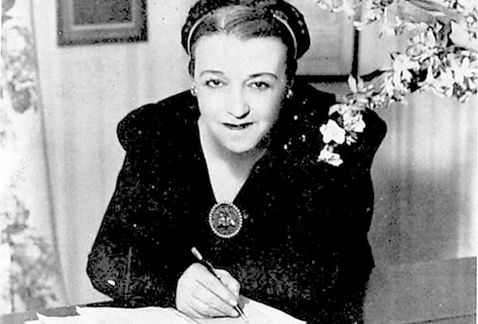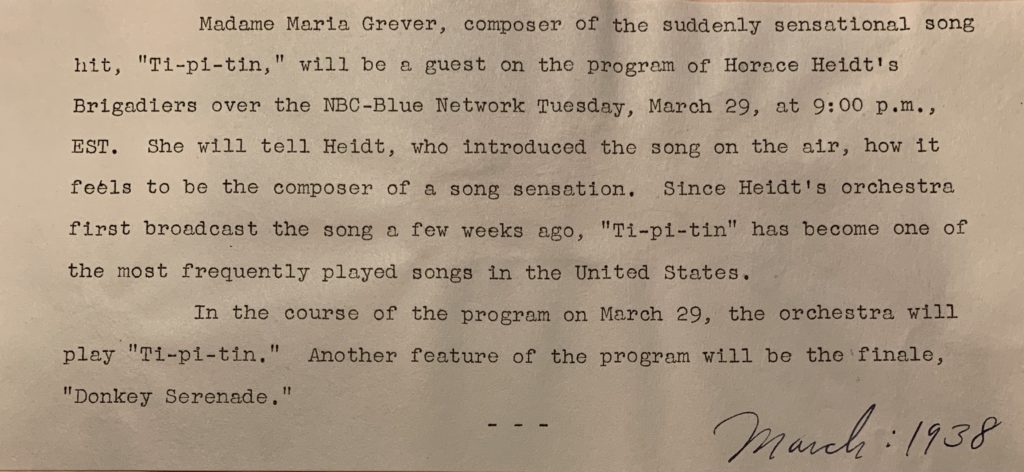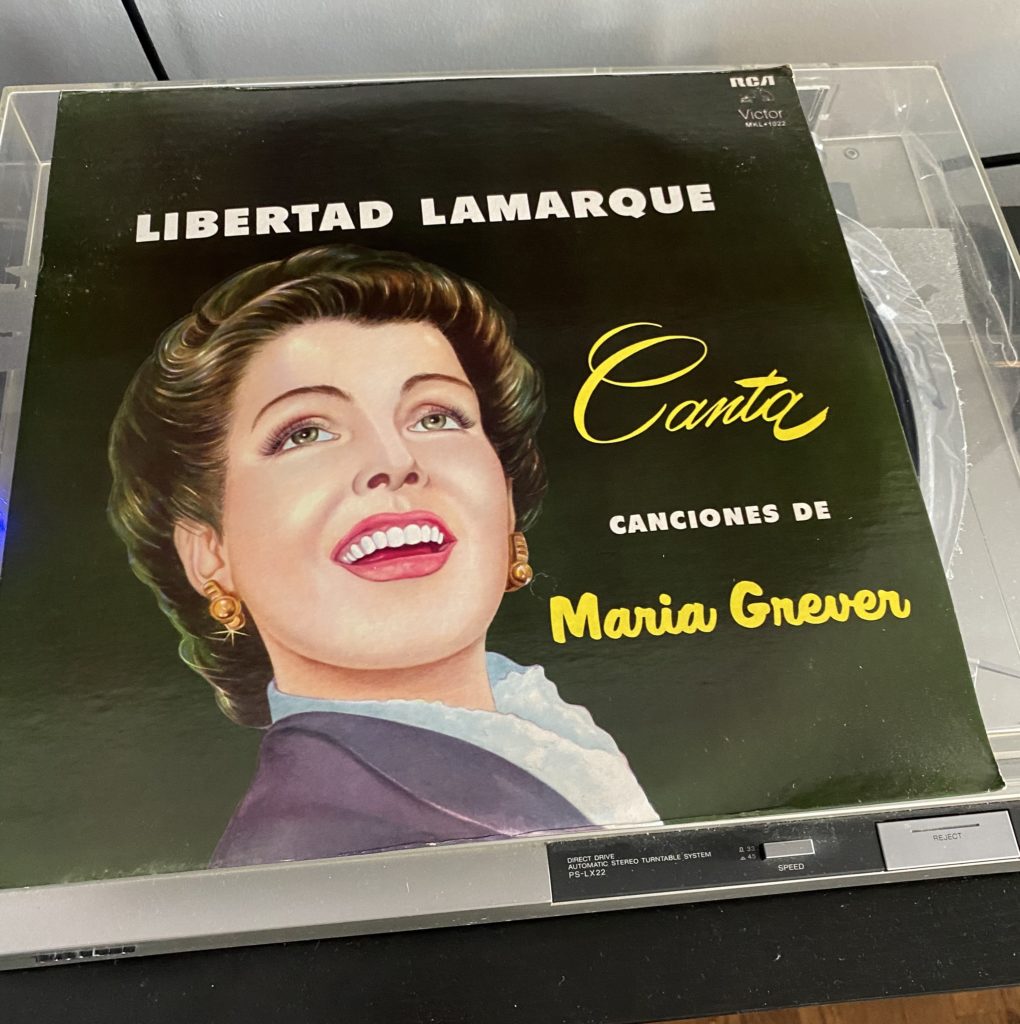Around two years ago, I discovered Maria Grever. She was a Mexican composer whose career started around the early to late 20s and continued up until her death in 1951. If you google her, you will find the same impressive stats. She composed around 800 songs (some places say 1000). Not only contemporary songs for the big movie houses – Paramount, MGM, Fox, but she wrote musicals, operas, and here’s where the light bulb will go off for some of you: She is the composer of “What a Difference a Day Makes” Is your mind blown yet? Mine was. What a Difference a Day Makes is one of my favorite songs, so why didn’t I know a woman, a Mexican woman, had composed this song in 1934? And so I began a quest to learn everything I could about her.
It was very random how I happened upon Mrs. Grever. My son who at the time was two years old was Face-Timing, my mom, a lot during the pandemic. She was singing this lullaby whose melody was familiar to me, but I don’t ever remember singing it. My son has this crazy ability to retain melodies and lyrics, so I had to dig around the internet for the lyrics so I could sing them with him. I eventually found it, Te Quiero Dijiste aka Muñequita Linda – music and lyrics by Maria Grever. I remember being excited it was a woman, but Grever didn’t automatically say Latina to me. When I realized she was Mexican, I became obsessed. If you’ve been following along with my blogs, you’ll know that my parents immigrated from the Dominican Republic. So that whole, “If you can see it, you can be it?” Right there! A Latina in NYC with two kids in the early part of the 20th century. What a discovery!
So who was Maria Grever?
Maria Joaquina de la Portilla Torres was born in 1885. (You’ll find various dates online, but according to official sources and public records, this is the most accurate). She was half Spanish and half Mexican and spent most of her childhood traveling back and forth between Spain and Mexico. She was a child prodigy. It’s documented she wrote a simple Christmas carol at the age of four. Nothing official, but it showed she had talent from a young age. She studied with Claude Debussy and Franz Lehar; her parents were supportive of learning from the best. They were a wealthy family, so they had the means for her to travel. Once her father passed, the family moved permanently back to Mexico. Maria Joaquina was about 15 years old.
In 1907, she married Leon Grever, an American businessman, and they had four children, only two of which survived past childhood. Maria Grever was writing some music in Mexico, but in 1916, everything changed as she took her two children to New York City. Leon stayed behind for work. This is right in the middle of the Mexican Revolution, so you can imagine it was a difficult moment in history to travel. The Mexican Revolution was primarily a civil war, but the United States got involved. So there was a lot of tension between the U.S. and Mexico. Nevertheless, Maria Grever arrives in the big apple, an immigrant, a woman, and a single mom (sort of).
Remember this is 1916, women still didn’t have the right to vote. And even when they did in 1920, Maria Grever was still an immigrant. If you do some digging, her leaving Mexico is documented as having fled due to political instability during the Revolution. But New York City isn’t a random target as an artist – especially a talent like Maria Grever. You went to New York City because you want to make it here. Because that’s where Tin Pan Alley was. Because that’s where the record companies were. Because everything was happening here. There was no internet then; you had to be physically here. So as I began to research, I started to piece together so much more. I’ll get to that a little later.
For now, here are some more facts on Maria Grever
She started performing in NYC fairly quickly. The earliest Newspaper clipping I found was from 1919 in the New York Tribune. It’s a review of a performance at the Princess Theater.
Newspapers.com Spanish Soprano plays Recital
She’s getting her name out there, not really performing her music just yet, but as anyone who is a musician knows, the best way to get heard is to make a name for yourself. And that she did. According to a book written by Maria Luisa Rodriguez Lee titled Maria Grever: Poeta y Compositora, she was writing between 1920-25, but the manuscripts have been lost. The first song to really make international headway, is a bolero titled “Jurame” published by G. Schirmer in 1926. Getting your song published was a big deal back then, since sheet music ruled the industry. It was basically the MP3 or LP of the day. The song gets picked up at a music shop by a famous Mexican tenor, Jose Mojica, and he releases his recording of the song in 1927 which fully establishes Maria Grever.
https://archive.org/details/78_jurame_jose-mojica-maria-grever_gbia0034799a]
From there she begins to get published with more frequency. She wrote “Cuando Vuelva A Tu Lado” in 1934 which was translated into English by Stanley Adams as “What A Difference A Day Makes.” This gets recorded by some of the biggest artists of the time – even artists like Bing Crosby
At this point, she joined ASCAP in 1935 and was a very active member according to newspaper clippings. Here she collaborated with some of the biggest lyricists of the day to translate her songs. Lyricists like Raymond Laveen. (Note just for translation! Maria Grever wrote all of her music AND lyrics!) Her biggest hit was “Ti pi Tin” released in 1938 translated into English by none other than Raymond Laveen.
It spent 6 weeks on Your Hit Parade which was that time’s Billboard Hot 100.
NYPL Horace Heidt sensation
Ti pi tin is actually fascinating because despite the success Maria Grever already had at that point, the publishers didn’t want to publish it. So Maria Grever created her own publishing company, Portilla Music publishing. What do you do when someone says no? You do it yourself. In the book by Rodriguez Lee Maria Grever is quoted as having said:
I had such a strong faith in the song, but the publishers thought I was crazy. I have been 20 years before an audience, and as a sensitive artist, I feel the vibrations of the public. I knew this song would be a success. So I published it myself (Lee 59)
At this point, Maria Grever was everywhere. She’s sought out by the big movie houses and starts composing for them. She’s getting radio play all over the country.
Radio Transcripts
She’s performing at Carnegie Hall, and in 1941 she writes the music for a Broadway Musical called “Viva O’Brien” The producers spent something like $80,000 on this musical – which in inflation translates to $1.5 million, but the play bombed. It was not open for long. The only thing that didn’t bomb was the praise for the music.
The new and outstanding personality of the production appears to be Marie Grever who wrote the music… Her dance numbers are lively and original and I suspect you will be hearing a good deal from her songs. [New York Daily News October 10, 1941]
In 1944, her song, Te Quiero Dijiste, the lullaby I discovered, was picked up for a movie called Bathing Beauty starring Red Skelton and Ester Williams. The tune, renamed as Magic is the Moonlight, is used throughout the movie as the theme, not just a part of the soundtrack, and it was a commercial success. She translated songs for Cole Porter. She even developed a program to teach singers Spanish through song – helping them with their diction. Maria Grever really did it all.
At the end of the 40s, she suffered a stroke which left her paralyzed on one side. She traveled to Mexico in 1949 to receive honors, the medal of Civil Merit, and the Medal of the Heart of Mexico. She remained active until her death in 1951 and in 1952 was declared Woman of the Americas by the Union of Women of the Americas. Mexico made a biopic about her in 1954 starring a very famous Latina actress of the time, Libertad Lamarque whose album in 1956 titled Libertad Lamarque “Canta Canciones de Maria Grever” or Songs of Maria Grever was a huge success. In 1959, Dinah Washington recorded her most famous cover of “What A Difference A Day Makes” and that earned a Grammy for Best R&B Performance that year. It was Washington’s first top 10 hit on the Billboard Hot 100. Maria Grever also has a scholarship named after her in Mexico City.
But who was she really? What I learned through my research
As a person, Maria Grever is somewhat of a mystery. In working on her story for PRX’s Latino USA, I was able to locate her family which was in and of itself a journey to find a living relative who would have enough information to speak about her.
“She was sort of a mystery … But even then, comparing stories that my father understood with stories that my tio understood, there were either gaps or completely different stories,” Stuart Livingston
Stuart Livingston, her great-grandson, works in the music industry. He told me that the family lore was that a well-known group of entertainers came to Mexico and convinced her to move to New York City. This tiny piece of information regardless of documentation or not changes her trajectory quite a bit. In the early 20th century, it was known that people traveled to other countries to mine talent, so it is possible that it’s true. The Maria Grever narrative then becomes, an aspiring composer leaves for New York City with her kids to make it in the big apple. Regardless of if her husband supported her endeavors, or what kind of support he may have given her in the early years. Once she was in NYC, she did it alone.
“You know, she had left Mexico, she left her husband behind. She was a single mother in a time where that was certainly not who you were supposed to be. And she was pursuing a career which was not the perceived right way for a woman to act,” Stuart Livingston
Maria Grever never reunited with her husband. Stuart says it was clear there was a separation. And in my research of public records, they very clearly never lived together again. So for someone like Maria Grever to achieve everything you read above, imagine the hustle she had to do. There are newspaper clippings from The Brooklyn Daily Eagle which say “Maria Grever is the busiest woman in all New York.”
She had to be in order to survive because if you know New York City, it really hasn’t changed all that much and she had two kids to feed. This was 100 years ago, when wiring money wasn’t a thing. Where it would’ve been very difficult for Leon Grever to send her money. So it was up to her to make ends meet.
“She oftentimes sold her music as opposed to keeping ownership and collecting royalties. It was due to her genius that she was able to make it work” Stuart Livingston
Maria wrote so much music that is not tied to her name because she did buyouts. That is why the number you find across the internet is so vast. According to Stuart, they have only about one-seventh or one-tenth of her music in her catalog that collects royalties. Nevertheless, it’s still an impressive body of work.
Her family is also quite impressive. Her son, Charles Grever, created Grever Music Publishing which became Grever International and housed a huge Mexican music catalog. It was because of the weight of Maria Grever’s name that they got that catalog. Her grandson, Bob Grever, was known as a Tejano music giant and was one of the biggest players in the Tejano music scene. He signed Selena Quintanilla when she was 12 years old (yes that Selena). His company, Cara Records, eventually joined Zomba records in the aughts, which was part of the powerhouse that brought you all your favorite boy bands – yes I mean Nsync, Backstreet Boys…oh yea and a young Britney Spears. Stuart Livingston was a partner of the label that took over the Fania records catalog, the Motown of salsa records. Her legacy and ear for music lives through them.
Why she is important
Maria Grever is important because she reminds us that women really can do anything. We all know how hard it is to work in the music industry today, and Maria Grever did what she did in a time when she had one sliver of the freedoms and rights we enjoy. She not only dealt with difficulties as a Mexican in New York but as a woman on top of that in an industry notoriously dominated by men. Men like Irving Berlin, Gershwin, Ernesto Lecuona from Cuba, and Carlos Gardel from Argentina. She was the first Latin American woman to receive international acclaim in the early part of the 20th century. We need to see people like her – people who have an accent, who left home, and who became one of the top composers of her time. Maria Grever’s story needs to continue to be told, and the only way that’s done is by keeping it present through the generations. If the stories of men in this business throughout history can be told, then we can certainly find the space to continue to keep Maria Grever’s legacy alive.
Working on this story connected a lot of dots for me. When I first moved here, I was doing a lot of archiving and restoration. So one of the first places I went to piece together her story was my old boss. He specializes in really old restoration projects – analog tape, lacquer discs, even metal discs. We had conversations about RCA/Victor, how the old recording industry worked, the classical music industry at the time, and what it was like at the beginning of the 20th century in NYC. And that wasn’t the end of my overlap. Towards the end of my production, I was looking for permissions for a song that ended up being owned by Sony/BMG. The song was on this album that my husband found a mint condition LP of (because he’s really good at finding that sort of thing).
A lot of Maria Grever’s catalog is owned by Universal Music Group (all of that is searchable through ASCAP or on allmusic.com), but this particular version of the song, “Cuando Vuelva A Tu Lado” was not. I started checking out the liner notes and details and realized it was RCA/Victor, and I had a vague memory of it becoming part of Sony. So I called up my old boss because we used to do (and he still does) tons of projects with Sony. And the person we used to interface with was in the department that works with licensing! When I emailed he had said he had recently wondered what I was up to, so it was a pretty big full-circle moment. It just goes to show that you really never know where you’ll end up. Sometimes it’s not the job you thought you’d end up doing, but you have to trust that in the end, the dots will connect.
Working on the Maria Grever story was so much more than just telling her story; it was an opportunity to really pull all of the pieces of everything I’ve worked on since I arrived in NYC together. As a mom in New York City, who oftentimes feels overwhelmed in this industry, it made me feel super proud to see another Latina who may have walked the same streets I have. I saw her running around to sell her sheet music, trying to get published, trying to have someone hear her out.
I’m so thrilled to share her with you. You can read more about her life in Maria Grever: Poeta y Compositora by Maria Luisa Rodriguez Lee. And I encourage you to check out the podcast on latinousa.org and hear from her family, more about her life and her legacy.






